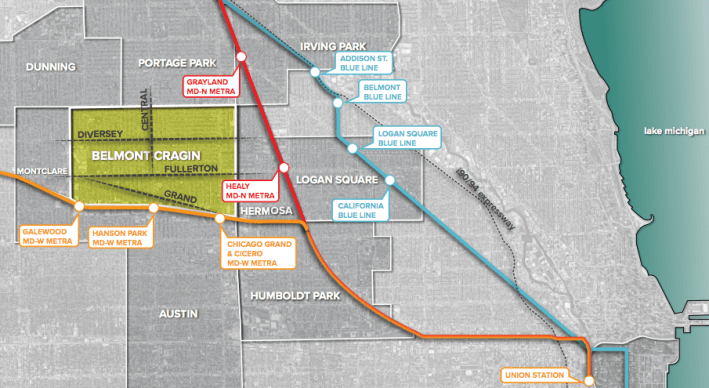As someone who went to high school in Belmont Cragin and spent a lot of time in the neighborhood, issues of transportation there are important to me. There wasn’t a week that went by that I wasn’t taking the Fullerton bus to get to school or walking around the neighborhood with friends. My senior year in high school, I co-facilitated an after-school writing program at another high school in the neighborhood, and I would walk two miles to get there.
Avenues for Growth Plan was published through a partnership between the Chicago Metropolitan Agency for Planning (CMAP) and the Northwest Side Housing Center. The plan is also an implementation effort of the Belmont Cragin Quality of Life Plan (QLP) completed in 2016 [PDF]. The QLP recommended the community pursue ways to improve the commercial corridors in the neighborhood, which included considering transportation, housing, and economic development.
Feedback was gathered through an advisory committee, which included a variety of community members and stakeholders. Other engagement strategies included a community meeting and a workshop with business owners. A survey – available in both English and Spanish – was also conducted and received over 350 responses. Over 70 percent of survey respondents indicated they drive to work and non-work destinations. Taking CTA buses was the second or third option. People replied that they think more frequent buses, faster buses with signal priority, and marketing Metra would improve transit transportation in the neighborhood.
According to the study, about 13,000 employees come to work in Belmont Cragin, while 1,000 Belmont Cragin residents live and work in the community. About 26,000 local residents work outside of Belmont Cragin, which underlines the need for local employment opportunities to lessen driving and commute times. Most of my friends from high school in the neighborhood drive further out to get to a job opportunity, so this rings true.
The plan also highlighted other key findings regarding transportation in the neighborhood. Sixty-four percent of Belmont Cragin residents drive alone to work, which is higher than the citywide rate of 52 percent. Belmont Cragin, the community area as a whole, has been identified by the Vision Zero Plan as a high-crash area.
The plan outlines some strategies to encourage alternatives to driving and create safer streets. One strategy seeks to encourage biking in Belmont-Cragin by adding signage to highlight bike routes on comfortable, low-traffic streets. They highlight Grand Avenue as the best location for a potential new protected bike lane in the neighborhood, particularly for its potential to calm traffic and improve safety for bike riders going east and west. However, Grand Avenue was repaved last year on some portions southwest of Belmont Cragin and the Chicago Department of Transportation chose not to install bike lanes or any traffic calming.
New bike infrastructure should be coupled with a new biking marketing campaign. This strategy probably won't be as effective as changing the streets to create real safety improvements.
The plan also suggests installing wayfinding signage to display directions to nearby Metra stations to encourage residents to ride Metra. In addition, residents suggest coordinating with Metra through education/marketing efforts to increase ridership.
Metra’s MD-West line has three stations on the southern border of Belmont Cragin, while its MD-North line has two stations less than one mile east and northeast, respectively, in adjacent community areas.

Considering the CTA’s assets in the community area, the plan outlines strategies to ask CTA – and CDOT, by extension – to implement improvements such as transit signal priority, all-door boarding, and adding more bus shelters along the corridors. Transit signal priority and all-door boarding drastically reduce travel times by waiting less time at intersections and waiting less time at stops, respectively.
The plan also asks CTA to consider local high schools’ schedules in linking bus schedules and stop locations with arrival and dismissal times.
Belmont-Cragin isn’t seen as a neighborhood with the best biking and non-driving options, which is clear from street design to lack of transit options. Major streets in the neighborhood like Grand and Fullerton have heavy car traffic and are not a safe option for cyclists. In their bus report card, the Active Transportation Alliance gave the Diversey Bus an “F,” which is a major bus going through Belmont-Cragin.
In high school, I actually made a video about the lack of CTA trains near Hermosa and Belmont-Cragin. These are all factors contributing to the car-culture in this part of the city. It you want to access the a CTA train, you need to take a bus out of the neighborhood. It is encouraging to see residents trying to increase Metra ridership at the very least. This plan outlines promising strategies for improving the quality of life for residents. There is a lot of potential in the community for alternatives to driving if there is commitment from leaders to implement some of the ideas of residents.






